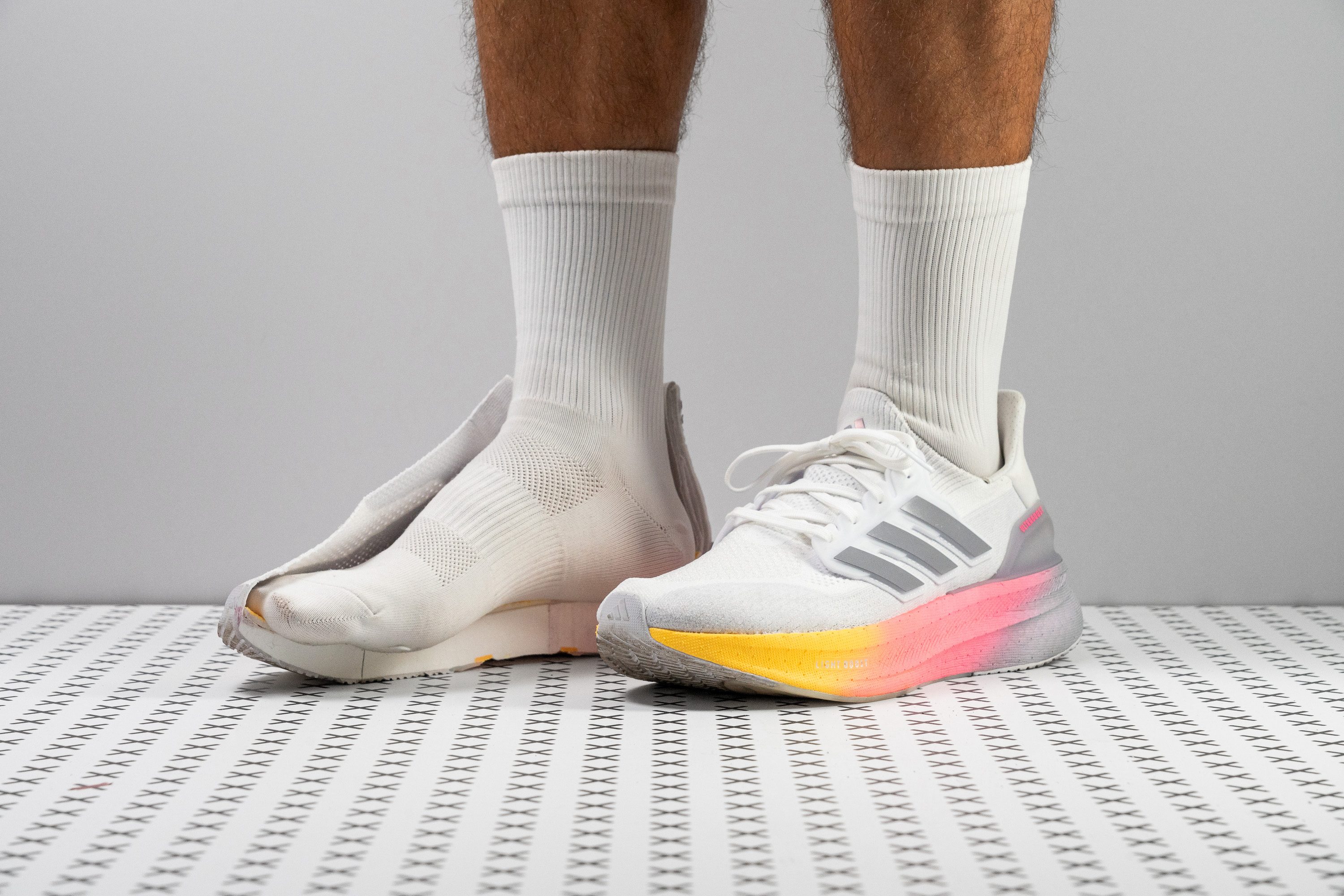Our verdict
- Top pick in best Adidas running shoes
- Top pick in best running shoes for bunions
Pros
- Enhanced midsole cushioning
- Roomy, comfortable knit upper
- Suitable for daily wear
- Excellent durability
- Optimised for heel strikers
- Superior Continental outsole
- More cushioned than ever before
- Can handle forefoot strikers
- Great for summer
Cons
- Could still be lighter
- Not suitable for fast paces
- Potential for heel slippage
Audience verdict
- Top 16% in road running shoes
- Top 15% in neutral running shoes
Comparison
The most similar running shoes compared
+ + Add a shoe | |||||
|---|---|---|---|---|---|
| Audience score | 90 Superb! | 89 Great! | 89 Great! | 93 Superb! | |
| Price | £160 | £120 | £150 | £130 | |
| Pace | Daily running | Daily running | Daily running | Daily runningTempo | |
| Shock absorption | Moderate | High | Moderate | High | |
| Energy return | High | Low | High | High | |
| Traction | High | Moderate | Moderate | Moderate | |
| Arch support | Neutral | Neutral | Neutral | Neutral | |
| Weight lab Weight brand | 10.3 oz / 292g 11.4 oz / 323g | 9.7 oz / 274g 9.5 oz / 270g | 9.9 oz / 281g 10 oz / 284g | 7.9 oz / 223g 7.9 oz / 224g | |
| Lightweight | ✗ | ✗ | ✗ | ✓ | |
| Drop lab Drop brand | 10.6 mm 10.0 mm | 10.5 mm 5.0 mm | 8.9 mm 8.0 mm | 8.0 mm 6.5 mm | |
| Strike pattern | Heel | Heel | HeelMid/forefoot | HeelMid/forefoot | |
| Size | True to size | True to size | True to size | True to size | |
| Midsole softness | Soft | Soft | Balanced | Balanced | |
| Difference in midsole softness in cold | Small | Normal | Small | Small | |
| Toebox durability | Decent | Bad | Decent | Bad | |
| Heel padding durability | Good | Decent | Bad | Good | |
| Outsole durability | Good | Good | Bad | Good | |
| Breathability | Breathable | Breathable | Moderate | Breathable | |
| Width / fit | Wide | Medium | Medium | Medium | |
| Toebox width | Wide | Medium | Medium | Medium | |
| Stiffness | Stiff | Moderate | Moderate | Flexible | |
| Torsional rigidity | Stiff | Stiff | Stiff | Stiff | |
| Heel counter stiffness | Moderate | Stiff | Stiff | Moderate | |
| Rocker | ✗ | ✗ | ✓ | ✓ | |
| Heel lab Heel brand | 35.2 mm 39.0 mm | 40.7 mm 40.0 mm | 36.1 mm 37.0 mm | 36.1 mm 38.5 mm | |
| Forefoot lab Forefoot brand | 24.6 mm 29.0 mm | 30.2 mm 35.0 mm | 27.2 mm 29.0 mm | 28.1 mm 32.0 mm | |
| Widths available | Normal | NormalWide | Normal | NormalWide | |
| Orthotic friendly | ✓ | ✓ | ✓ | ✓ | |
| Season | SummerAll seasons | SummerAll seasons | All seasons | SummerAll seasons | |
| Removable insole | ✓ | ✓ | ✓ | ✓ | |
| Ranking | #52 Top 14% | #104 Top 28% | #92 Top 25% | #4 Top 2% | |
| Popularity | #193 Bottom 48% | #242 Bottom 35% | #232 Bottom 38% | #15 Top 4% |
Who should buy
We’re convinced the Ultraboost 5 is an excellent choice for:
- Fans of the original Ultraboost who want a roomier fit with more toe splay and additional comfort, along with extra foam underfoot.
- Those without a tight budget seeking a premium daily trainer featuring a superb knit upper.
- Runners who casually go out for 1 to 3 runs per week and need a durable shoe that doubles as an everyday option for all life’s activities.

Who should NOT buy
We think the Ultraboost 5, despite its improvements, still doesn't offer the best value for runners. While the shoe boasts a quality upper and durable outsole, it falls short in terms of weight. We've found in the lab that lighter and more responsive alternatives like the ASICS Novablast 4 and Hoka Clifton 9 provide better value.
And of course, price continues to be a significant factor with the Ultraboost. For those seeking a similar but more affordable option, the Adidas Ultrabounce is a worthy alternative. If you're interested in a shoe where the quality of the midsole justifies a premium price, consider the Saucony Triumph 22.
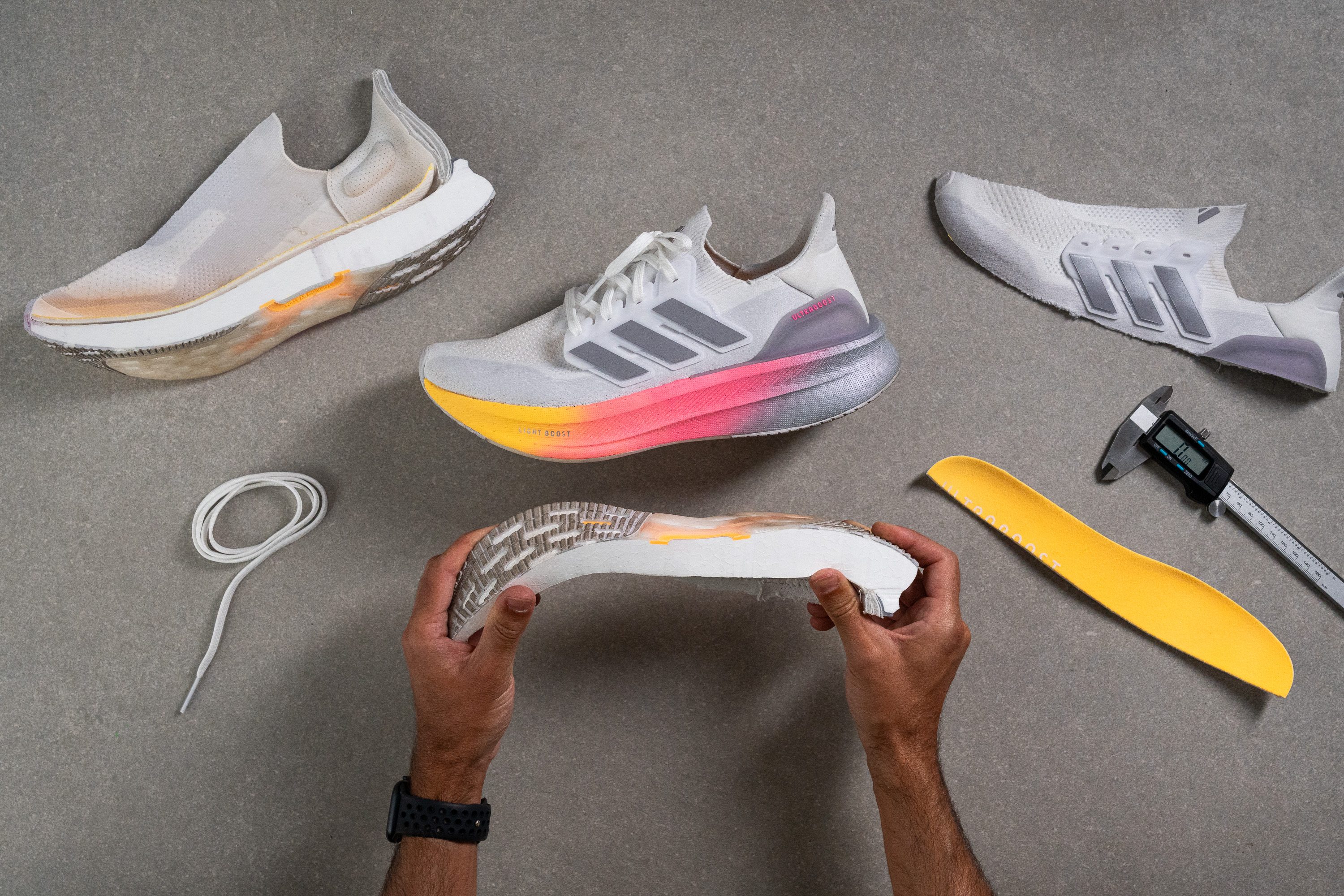
Cushioning
Shock absorption
Shock absorption isn’t a concern in the Ultraboost 5 at all. Our ASTM F1976 test showed a solid 126 SA in the heel, which aligns with its average stack height and makes it versatile enough for anything from relaxed jogs to extended efforts.

| Ultraboost 5 | 126 SA |
| Average | 129 SA |
Energy return
In terms of energy return, Light Boost never disappoints. Since it’s a TPU-based foam rather than EVA, it typically outperforms most daily trainers.
We measured 66% in the heel and 69.5% in the forefoot—both standout results for this category. Still, it's true that considering the price point of this shoe, we definitely expect more than average performance.
| Ultraboost 5 | 66.0% |
| Average | 58.5% |
Heel stack
Despite its appearance of being incredibly cushioned, the Ultraboost 5 actually measures around the average with a 35.2 mm stack height. With current design trends in running shoes, this provides more than enough cushioning for most runners, even on long runs.
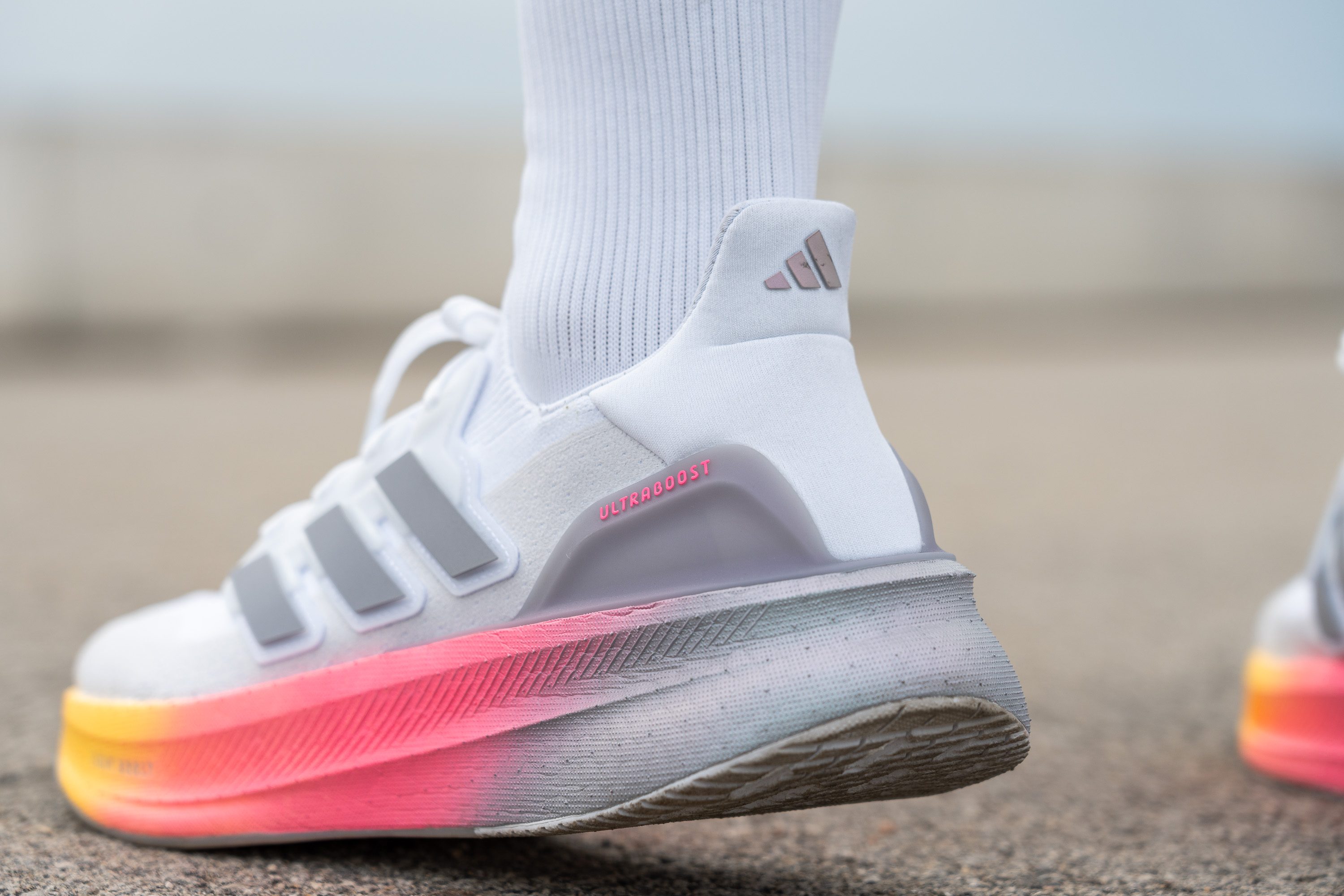
We believe that adding more stack to this shoe would not be a good idea by any means. If it already weighs over 10 oz with a 35 mm stack, increasing it to over 40 mm would simply make it too heavy.

| Ultraboost 5 | 35.2 mm |
| Average | 34.8 mm |
Forefoot stack
The forefoot in previous Ultraboost models often left us disappointed, making it difficult to recommend for runners who aren’t heel strikers.

However, we found that Adidas has made a significant improvement in this area, increasing the cushioning from a mere 18.2 mm in the Ultraboost Light to a much more substantial 24.6 mm. This is a much-needed and appreciated improvement, though it falls short of Adidas' more optimistic measurements of 39/29 mm.

| Ultraboost 5 | 24.6 mm |
| Average | 26.2 mm |
Drop
Adidas claims the Ultraboost 5 has a 10 mm heel-to-toe drop, and we put that to the test in our lab. Using the official guidelines from World Athletics, we measured it with our callipers at 10.6 mm—nearly spot on! We were pleased with this result, as a difference of just 0.6 mm is hardly noticeable.
With this drop, the Ultraboost 5 clearly targets heel strikers, but from our perspective, the increased cushioning makes it a solid choice for all types of runners.
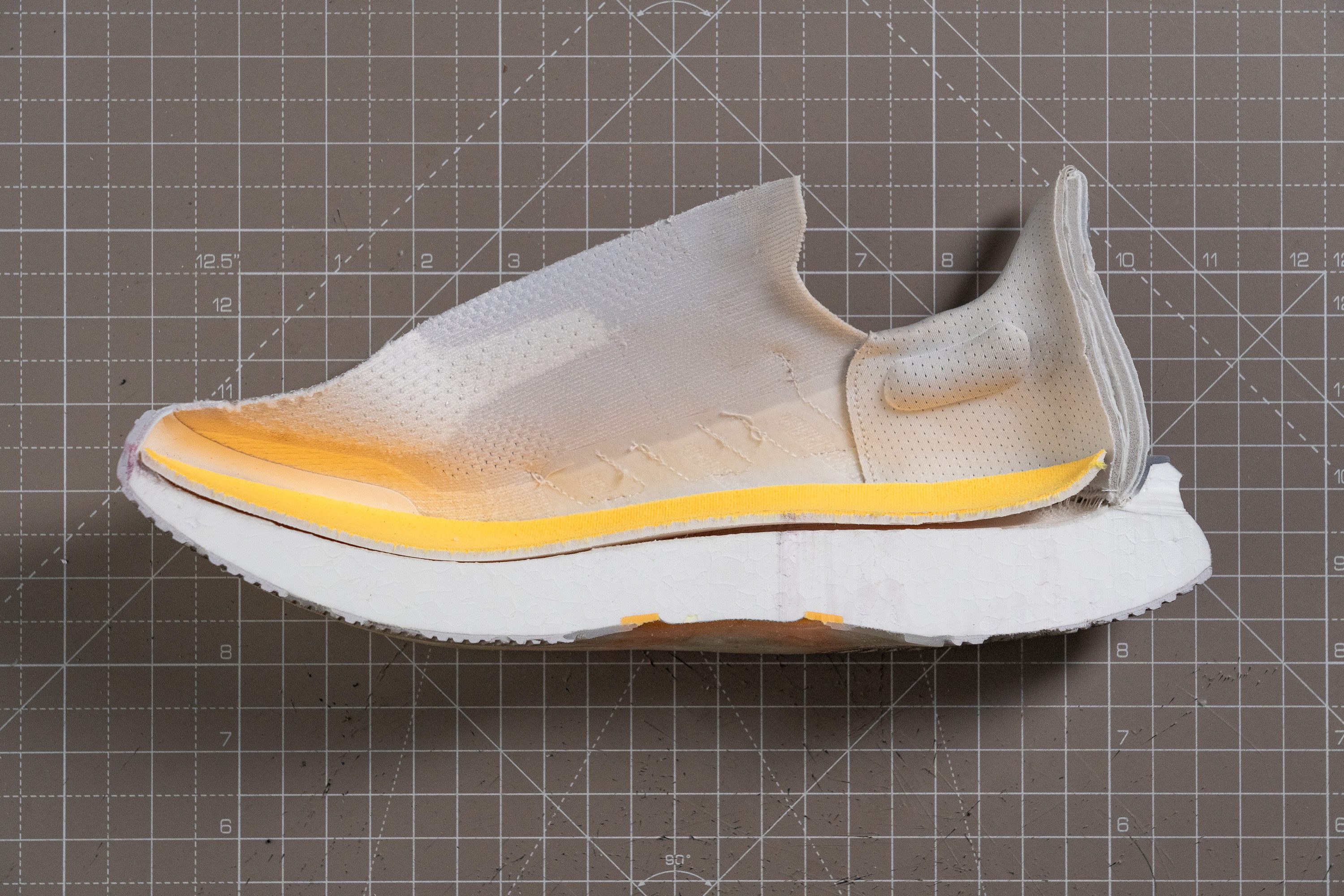
| Ultraboost 5 | 10.6 mm |
| Average | 8.6 mm |
Midsole softness
From 2015 to 2023, Adidas has relied on its Boost foam in the Ultraboost lineup—hence the name. Initially, Boost was an incredible innovation, but over the years, its heft became a major drawback. That’s why we were pleased when Adidas finally introduced Light Boost, even though it arrived a bit later than we’d hoped.
The new Light Boost isn’t just 30% lighter than the original Boost, it’s also slightly softer underfoot. We tested this with our durometer, finding that the Ultraboost 1.0 scored 19.9 HA, while Light Boost in the Ultraboost 5 came in at 17.0 HA—a minor difference, but one you can feel.
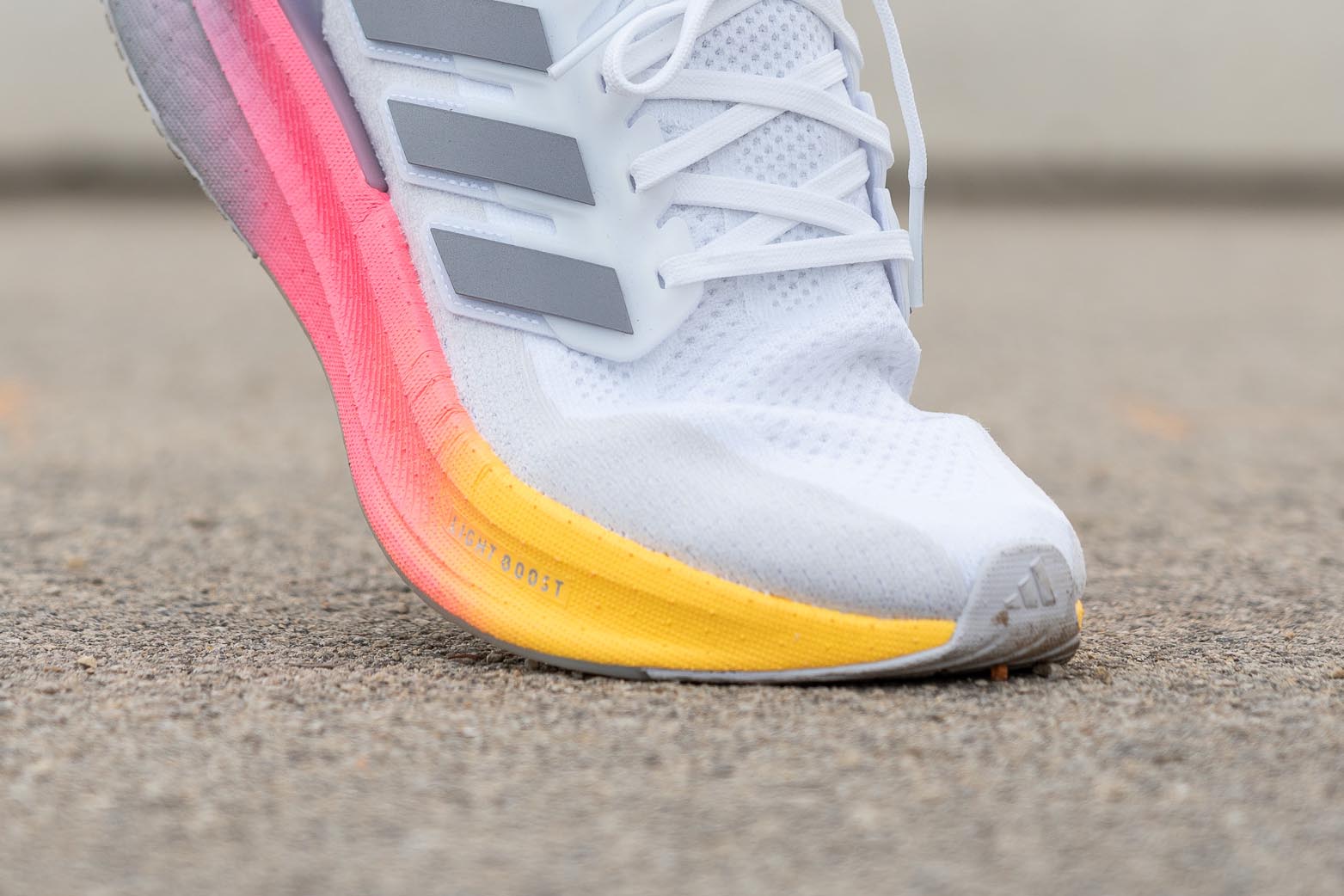
However, what hasn’t improved is the energy return. From our perspective, you shouldn’t expect miracles with the Ultraboost 5. While it’s still a bouncier foam than the average EVA—something we expect at a £180 price point—it’s nowhere near the level of top-tier supertrainers like the ASICS Superblast 2.
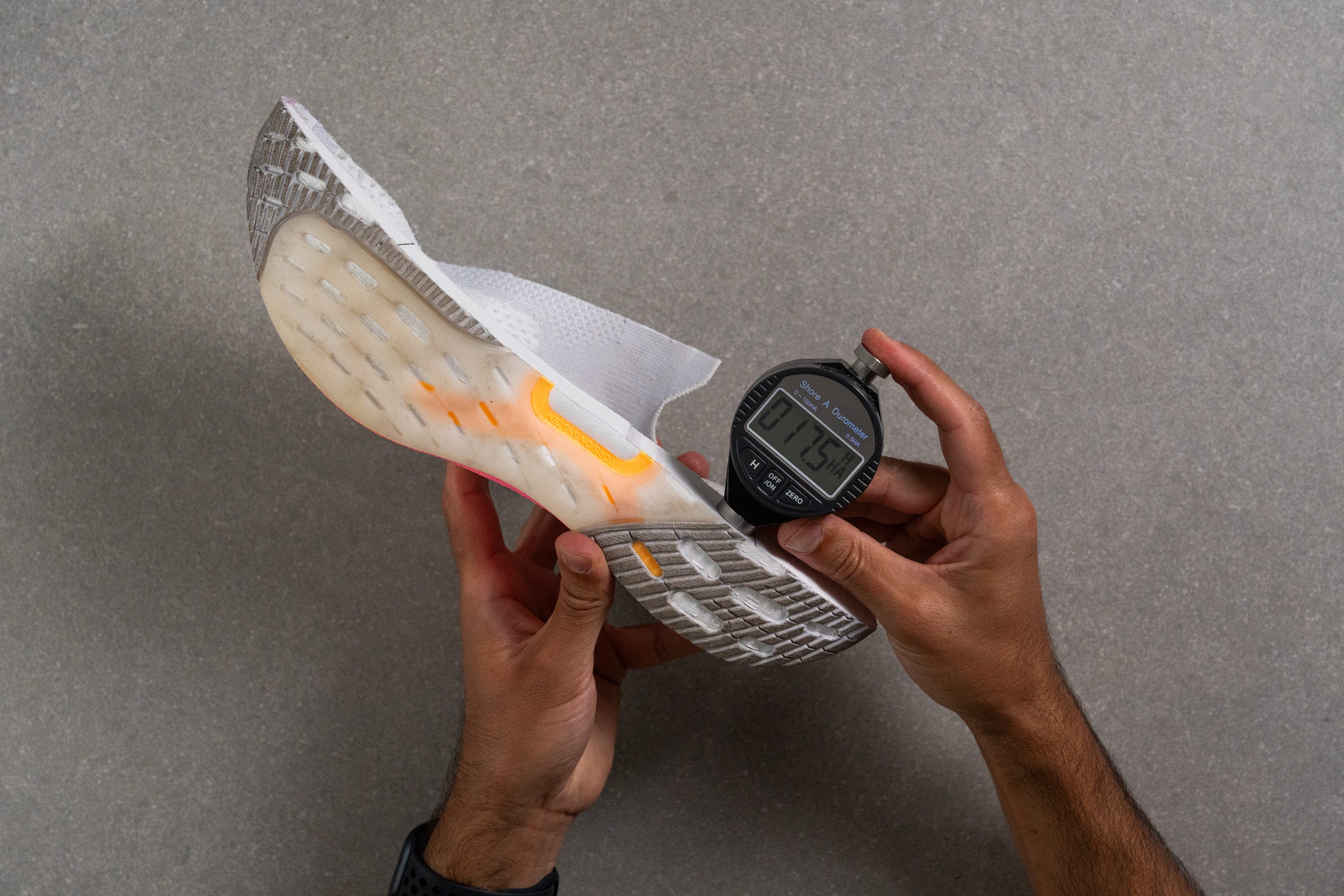
| Ultraboost 5 | 17.0 HA |
| Average | 20.4 HA |
Rocker
The current trend in running shoe design may favor rockered profiles with significant toe spring, but the Ultraboost 5 stays true to a classic, flatter design—and we’re happy about it. We found that this makes it perfect for daily runs and versatile enough for everyday activities, whether you're heading to the gym or grabbing some groceries.
Size and fit
Size
Adidas Ultraboost 5 fits true to size (89 votes).
Width / Fit
Adidas tried both extremes with the shoe dimensions between the narrow Ultraboost 1.0 and the wide Ultraboost Light. That's why we weren’t sure which direction they would take with the Ultraboost 5.
After carefully measuring the gel mould with our callipers, we’re excited to share that the shoe is impressively wide and spacious, coming in at a generous 98.4 mm. We found that this is a true blessing for those with broader feet, although makes this one unsuitable for runners with narrow feet.
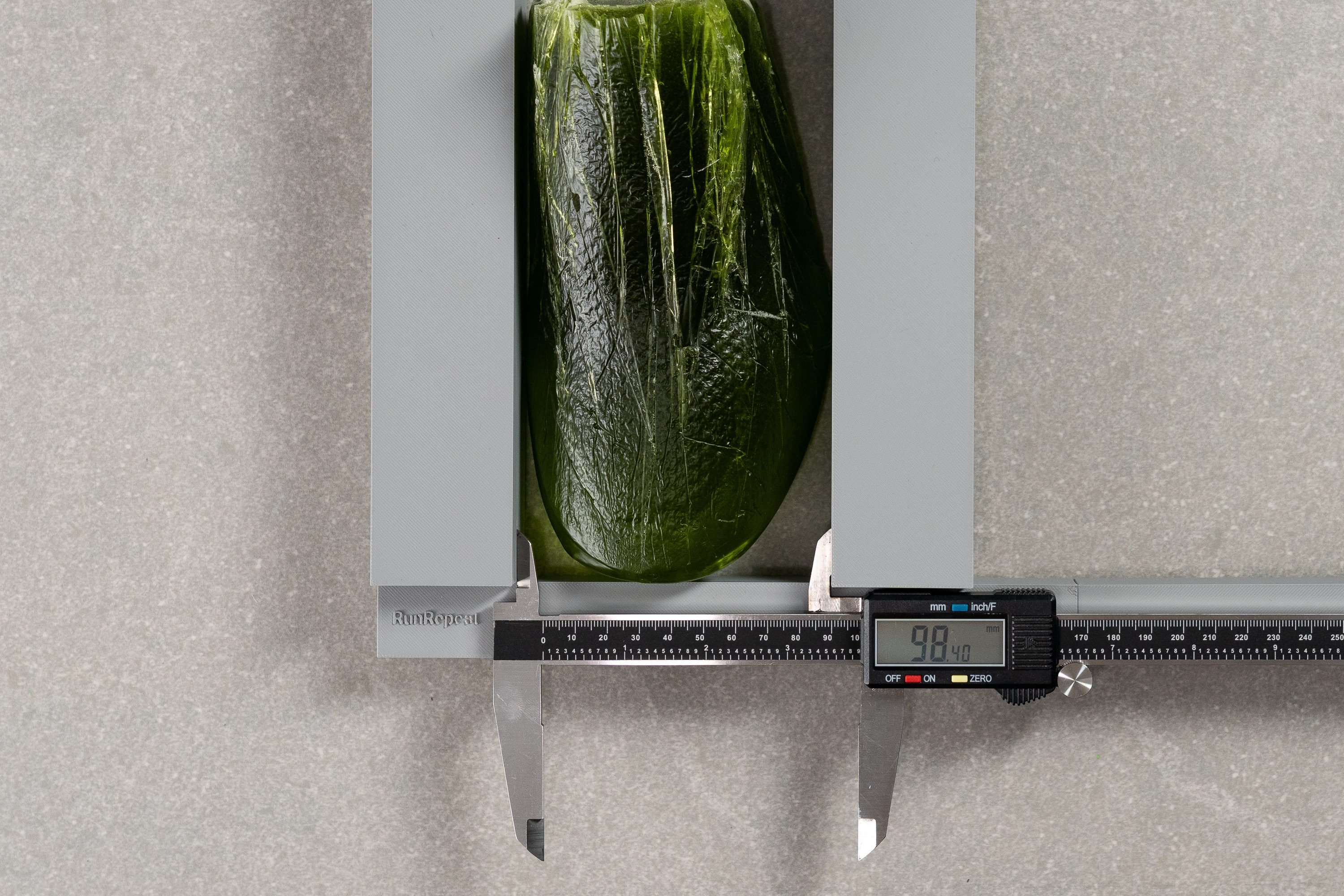
| Ultraboost 5 | 98.4 mm |
| Average | 95.1 mm |
Toebox width
We took a second measurement to assess the toebox's taper and found it comfortably spacious at 78.6 mm.
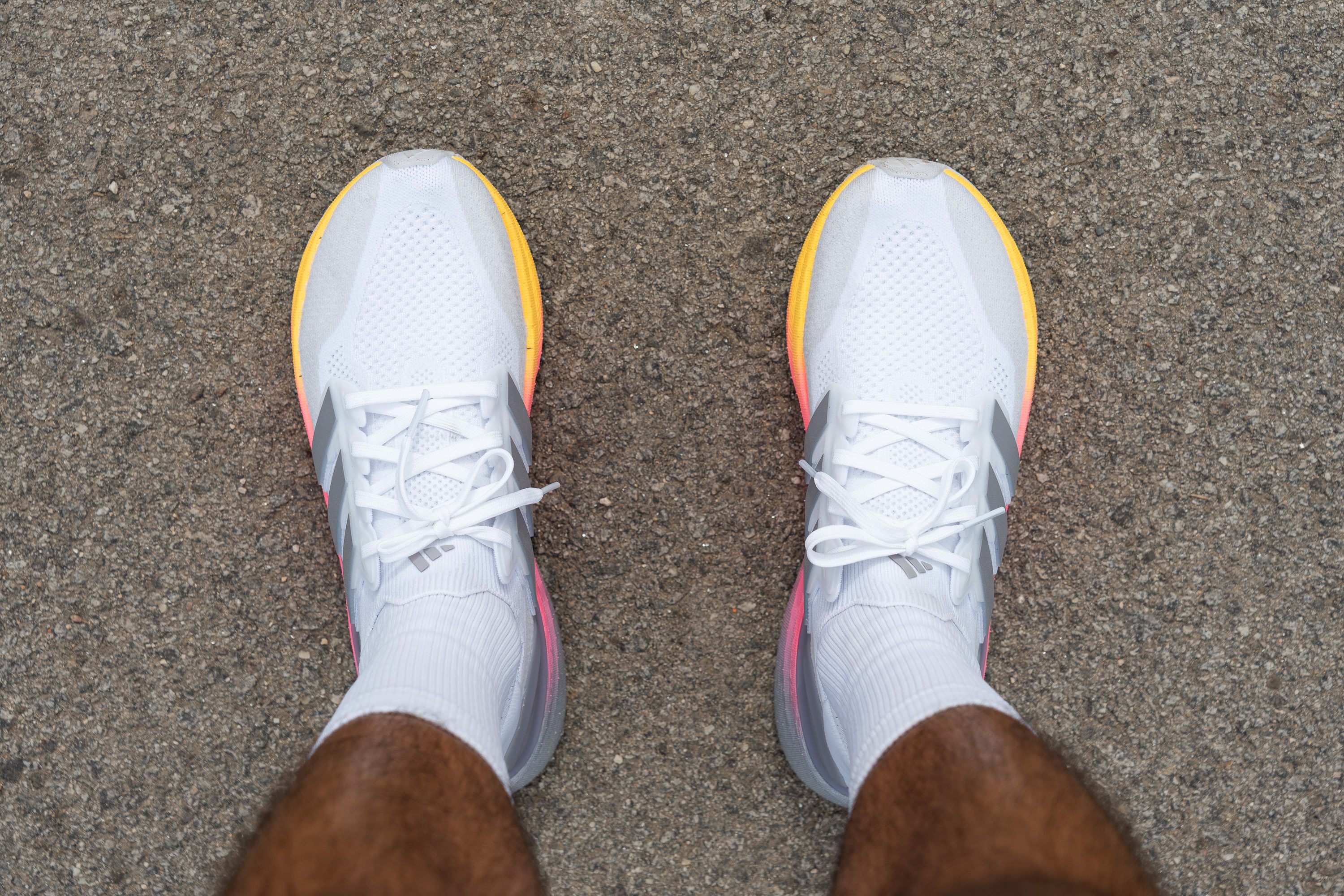
This confirmed our experience while running in the Ultraboost 5—we found it allows for superior toe splay, especially with its hyper-stretchy Primeknit upper.
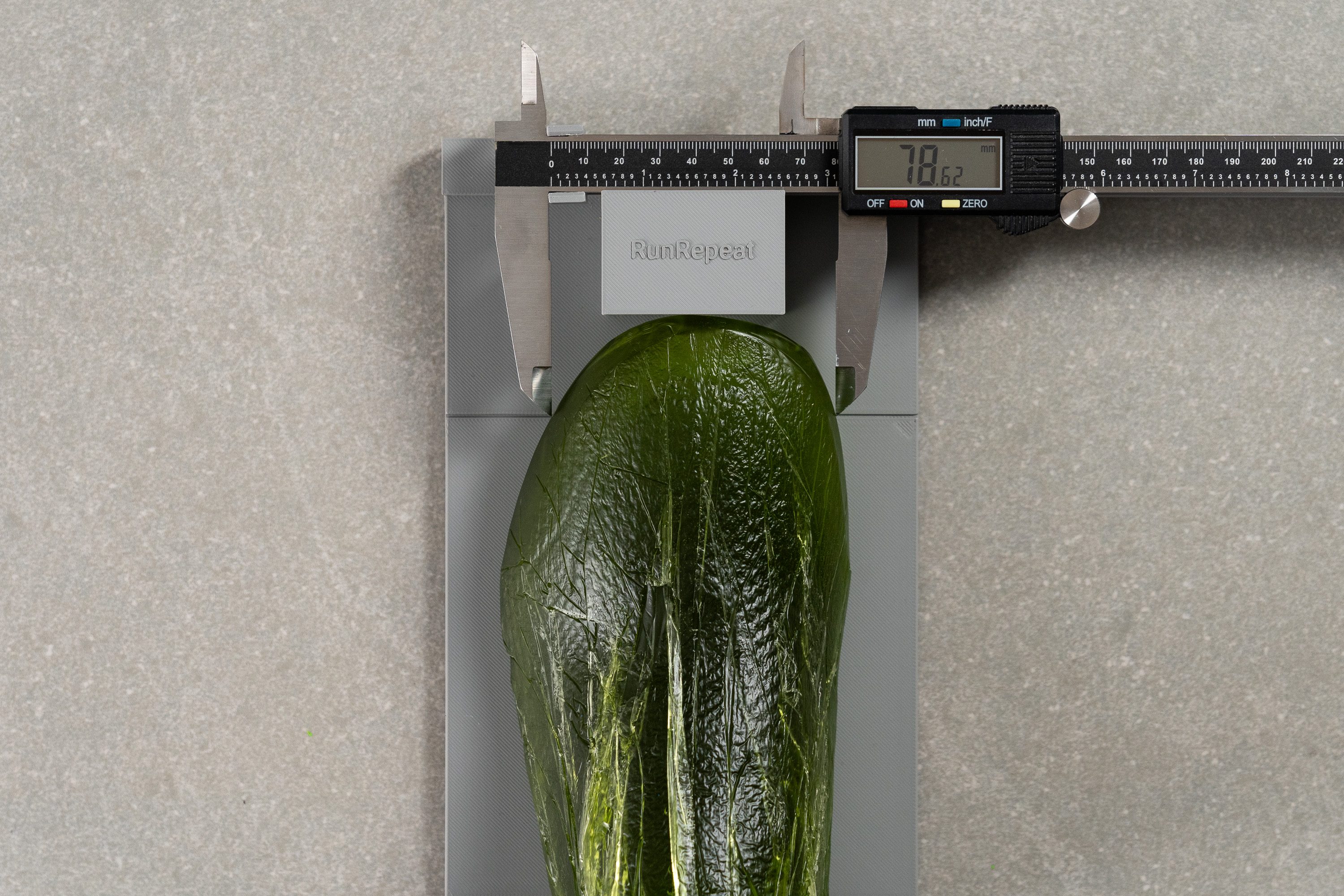
| Ultraboost 5 | 78.6 mm |
| Average | 73.2 mm |
Toebox height
To complete the picture, the vertical height is on the more spacious side at 27.9 mm, which can improve after some weeks thanks to the stretchy material of the upper.
Based on our measurement and a data-driven approach, we’re convinced that the Ultraboost 5 is the most generously-designed version to date!
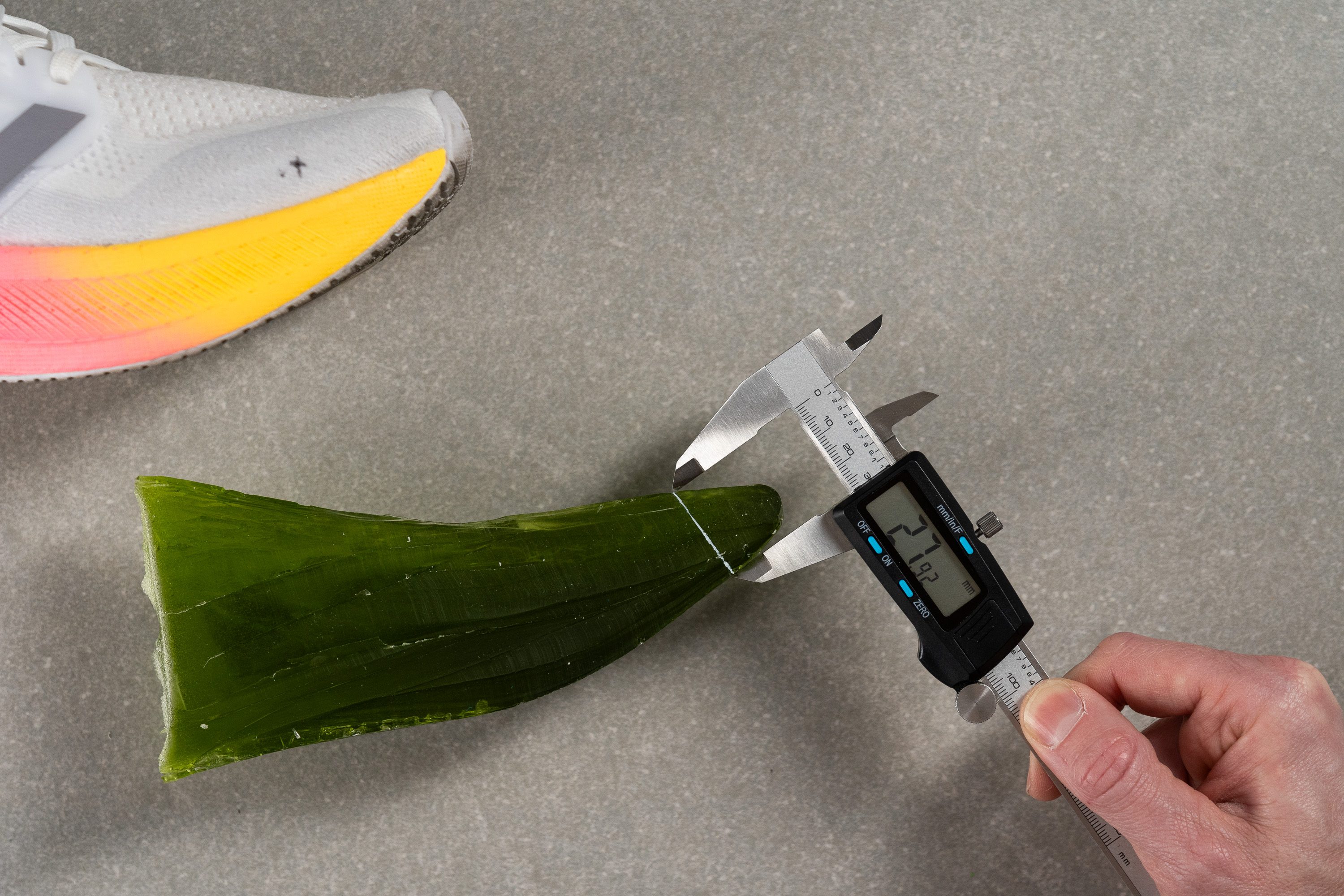
| Ultraboost 5 | 27.9 mm |
| Average | 27.1 mm |
Traction / Grip
Traction test
One of the standout features that made the Ultraboost 1.0 incredibly popular was its excellent Continental outsole, which offered good grip and impressive durability. We discovered that Adidas has continued its partnership with the German car tyre manufacturer in the Ultraboost 5, setting high expectations here in the lab.
After we secured the UB5 to our traction machine, we found a 0.46 score, which is around average. That ensures good grip on both wet and dry ground, though we expected a bit more from Conti.
| Ultraboost 5 | 0.46 |
| Average | 0.48 |
Outsole design
The Ultraboost 5 blends partial Continental rubber coverage with small exposed foam zones. Rubber is focused on the forefoot and heel, while the midfoot uses a lighter, translucent compound that contributed to the less-than-impressive grip we measured in the lab.
This photo also reveals the yellow torsion system embedded beneath the outsole—a key feature that boosts rigidity and helps control excessive twisting during foot transitions.
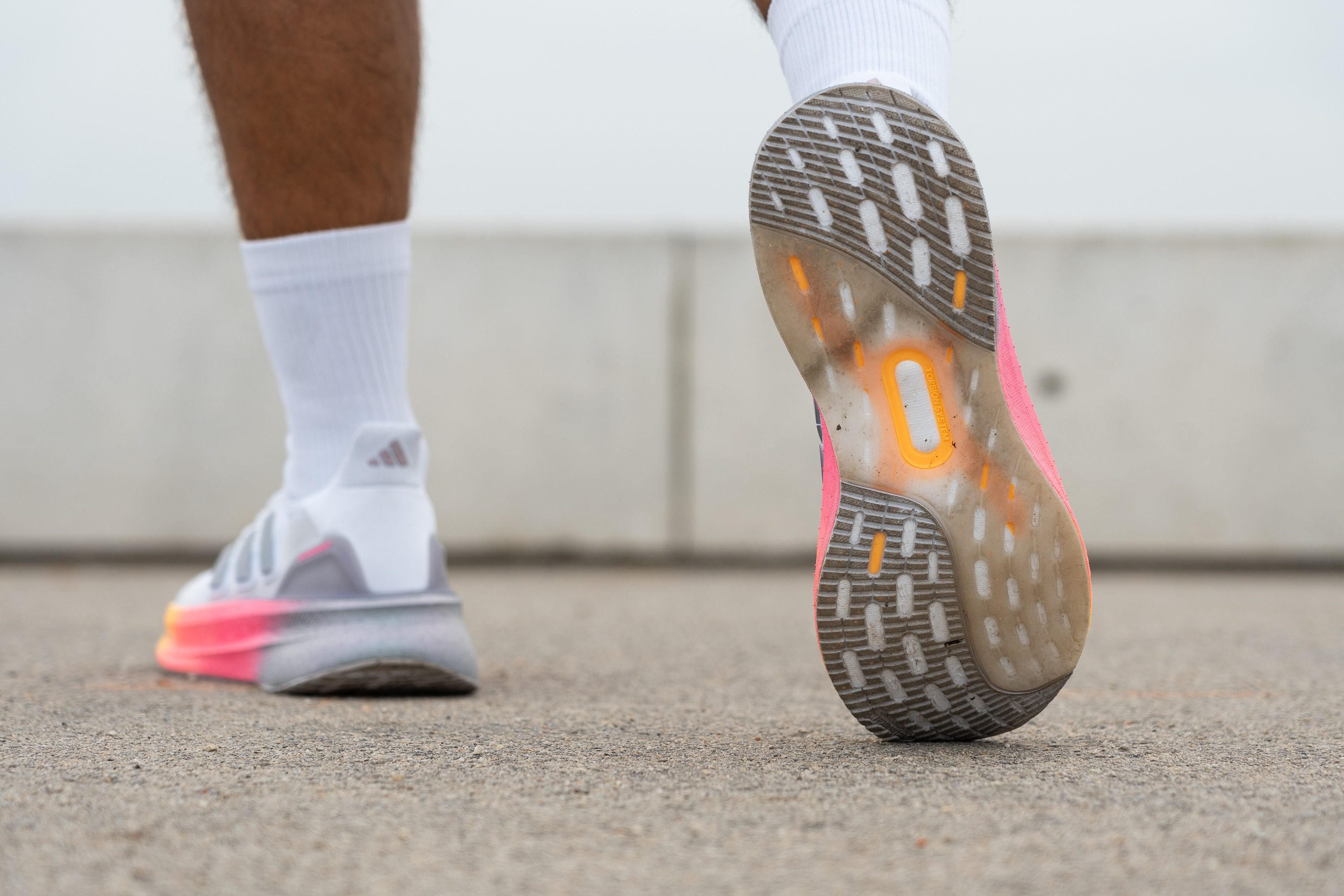
Flexibility / Stiffness
The Ultraboost has always stirred debate—first created for running, its sleek design made it explode in popularity as a lifestyle sneaker after Kanye West rocked the triple-white version at the 2015 Billboard Awards.
However, each new version becomes noticeably stiffer with the updated Torsion System, shifting back toward performance over streetwear. The Ultraboost 5 even surpassed the average in our 30-degree bend test, requiring 17.3N to flex... making it the least sneaker-like model so far.
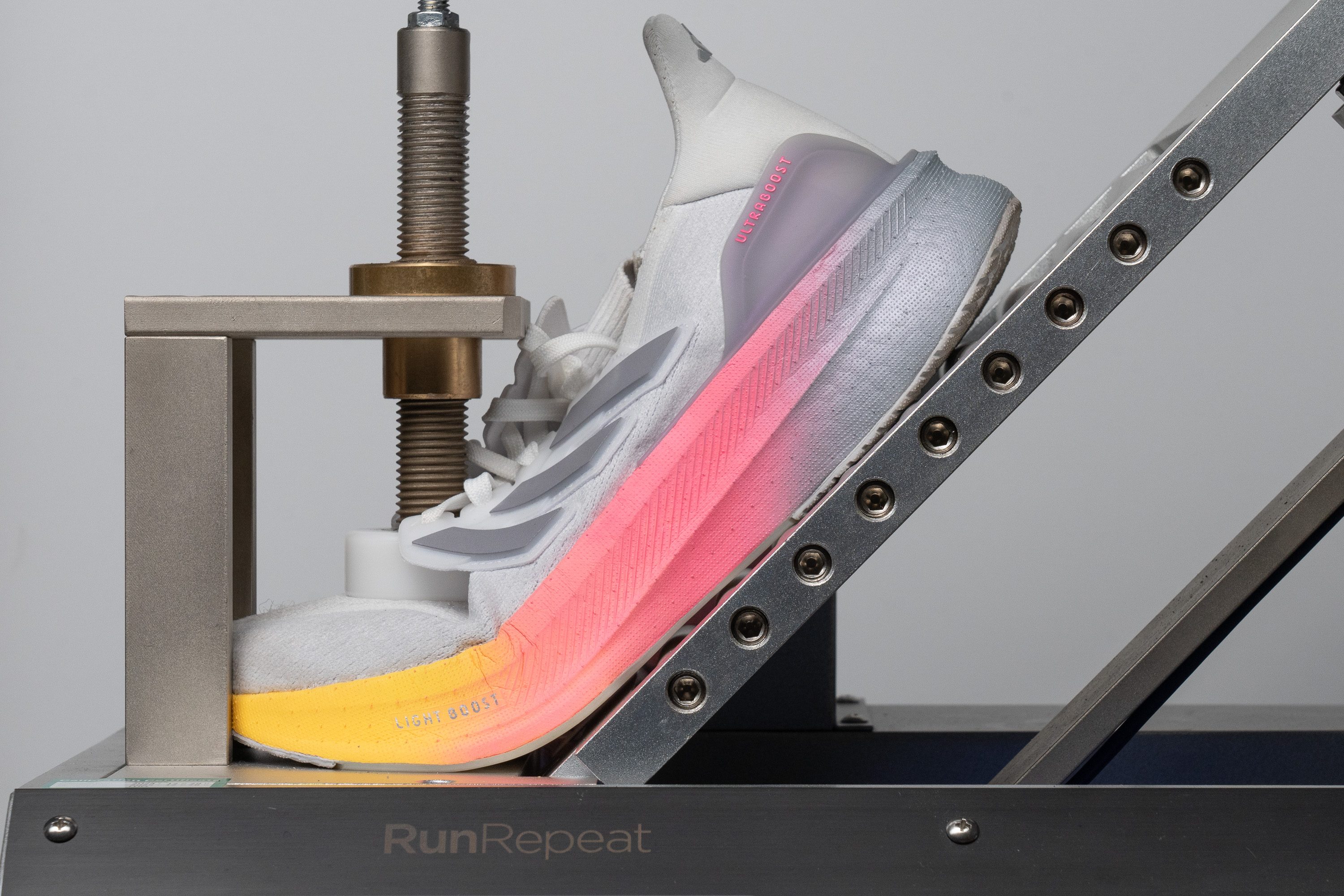
| Ultraboost 5 | 17.3N |
| Average | 15.3N |
Stiffness in cold (%)
Light Boost performed exceptionally well in our initial test under cold temperatures, and we’re thrilled to report that it not only maintained its softness but also its flexibility, becoming just 19% stiffer.
| Ultraboost 5 | 19% |
| Average | 33% |
Weight
One of the persistent challenges with every Ultraboost has been its weight-to-cushioning ratio. In the latest "Light" version, Adidas addressed this by bringing the shoe down to 10.76 oz (305g). Now, with the Ultraboost 5, the weight has further decreased to 10.3 oz (292g).
We found this to be a much-needed improvement, and we certainly appreciate the effort. However, we believe that Adidas should aim to bring the weight below the 10 oz mark to make it even more appealing to a broader range of runners. We’ll be watching to see if they can achieve this!
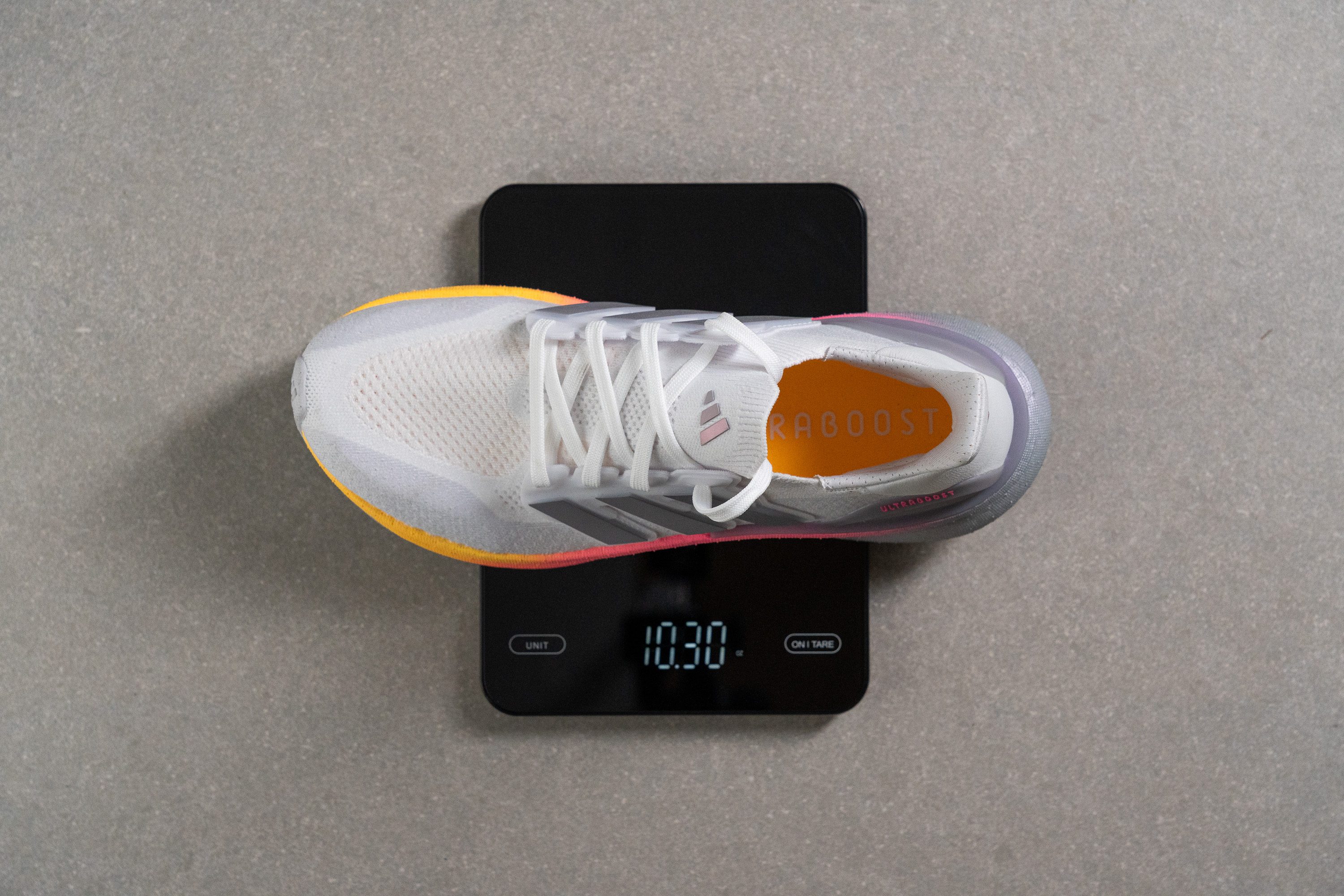
| Ultraboost 5 | 10.3 oz (292g) |
| Average | 9.3 oz (264g) |
Breathability
Our lab review of the Ultraboost Light left us slightly underwhelmed in the breathability department, earning just a 3/5.
In contrast, the Ultraboost 5 features an all-new Primeknit upper that, from our perspective, appears better ventilated at first glance. Luckily, we confirmed this improvement during our smoke test, where it achieved a perfect 5/5.
Using a light, it’s incredibly clear how Adidas nailed it this time. They skillfully combined thicker sections on the lateral side of the UB5 with thinner, perforated areas in the toebox and tongue—and it truly works wonders for both stability and breathability.

This high level of breathability is possible thanks to the new Primeknit upper. It's not as thick as it was on the previous versions, and the ventilation holes effectively allow hot air to escape from the shoe.
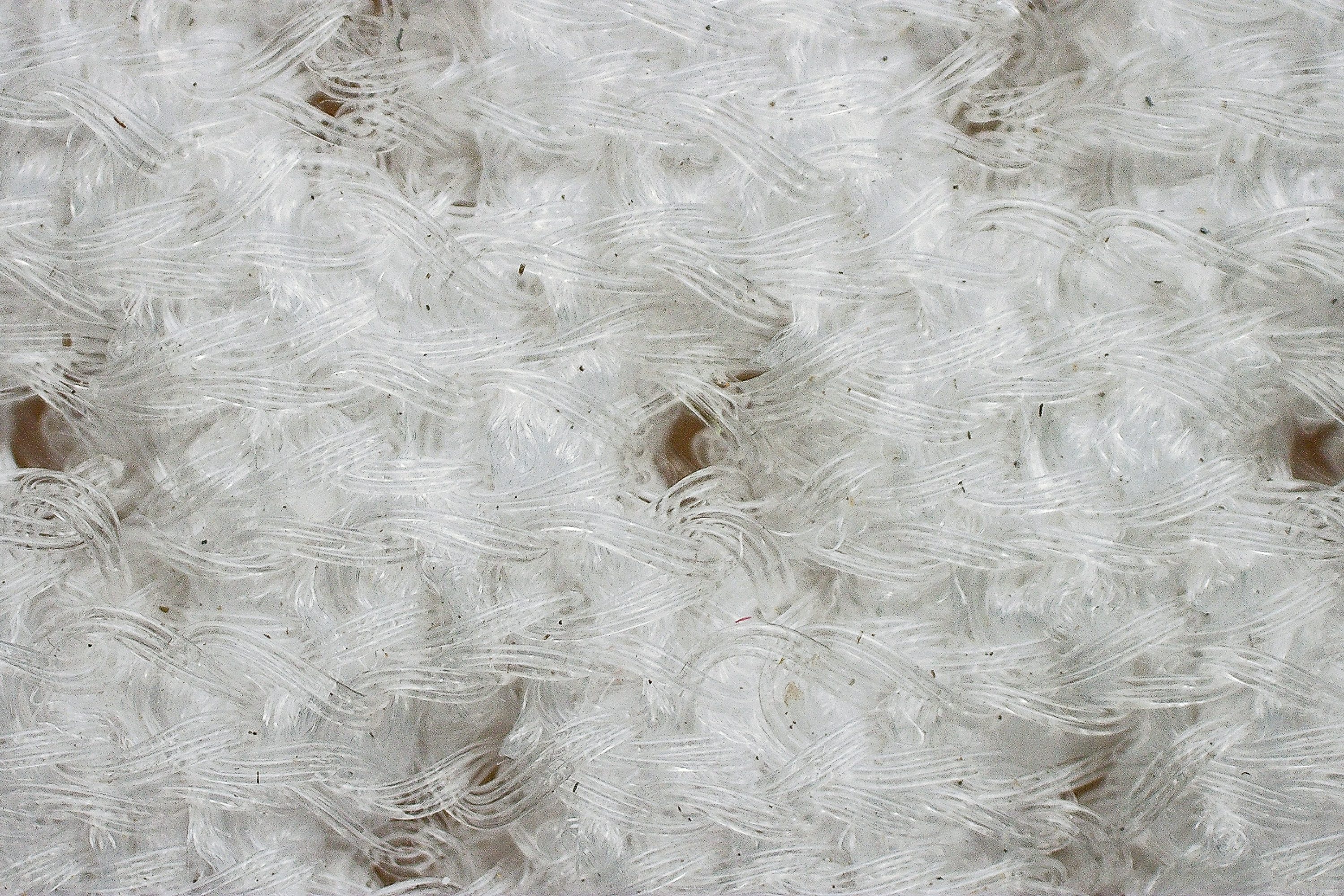
Overall, this is exactly what we expect from a luxurious upper. It’s stretchy, ventilated, comfortable, soft, and seamless, made from a single piece. In our view, this is one of the standout highlights of the Ultraboost 5!
| Ultraboost 5 | 5 |
| Average | 3.7 |
Stability
Lateral stability test
The Ultraboost lineup has always been designed as a neutral running shoe, and the Ultraboost 5 is no exception—it’s still not the best option for those with stability needs.
However, that doesn’t mean it’s an unstable shoe. Light Boost isn’t a super soft foam, and the lace cage, along with the plastic clips in the heel, helps secure the foot, especially when taking corners.
Torsional rigidity
We anticipated a high score for the Ultraboost 5 in our torsional rigidity test, mainly due to the Adidas Torsion System technology. This X-shaped orange plastic piece adds a rigid element to the midsole, although it's less stiff than a carbon plate.

From our perspective, scoring 4/5 in our torsional rigidity test was expected. We observed that during runs, this added stability is quite noticeable. However, the shoe feels slightly less comfortable and natural than we had hoped.
When it comes to running shoes, it's impossible to have it all!
| Ultraboost 5 | 4 |
| Average | 3.5 |
Heel counter stiffness
The heel counter features the classic Ultraboost design we’ve come to recognize since 2015. We found that it includes two plastic clips on the sides, adding a touch of stiffness that complements the pliable, sock-like upper. This combination led to an average 3/5 in our manual assessment and it's helpful for heel strikers with mild stability issues.
| Ultraboost 5 | 3 |
| Average | 2.9 |
Midsole width - forefoot
This is the best Ultraboost yet for forefoot and midfoot strikers, thanks to its increased forefoot stack and the added width in this area, which enhances stability and control.
We measured the forefoot width with our digital callipers and found it to be 115.6 mm.
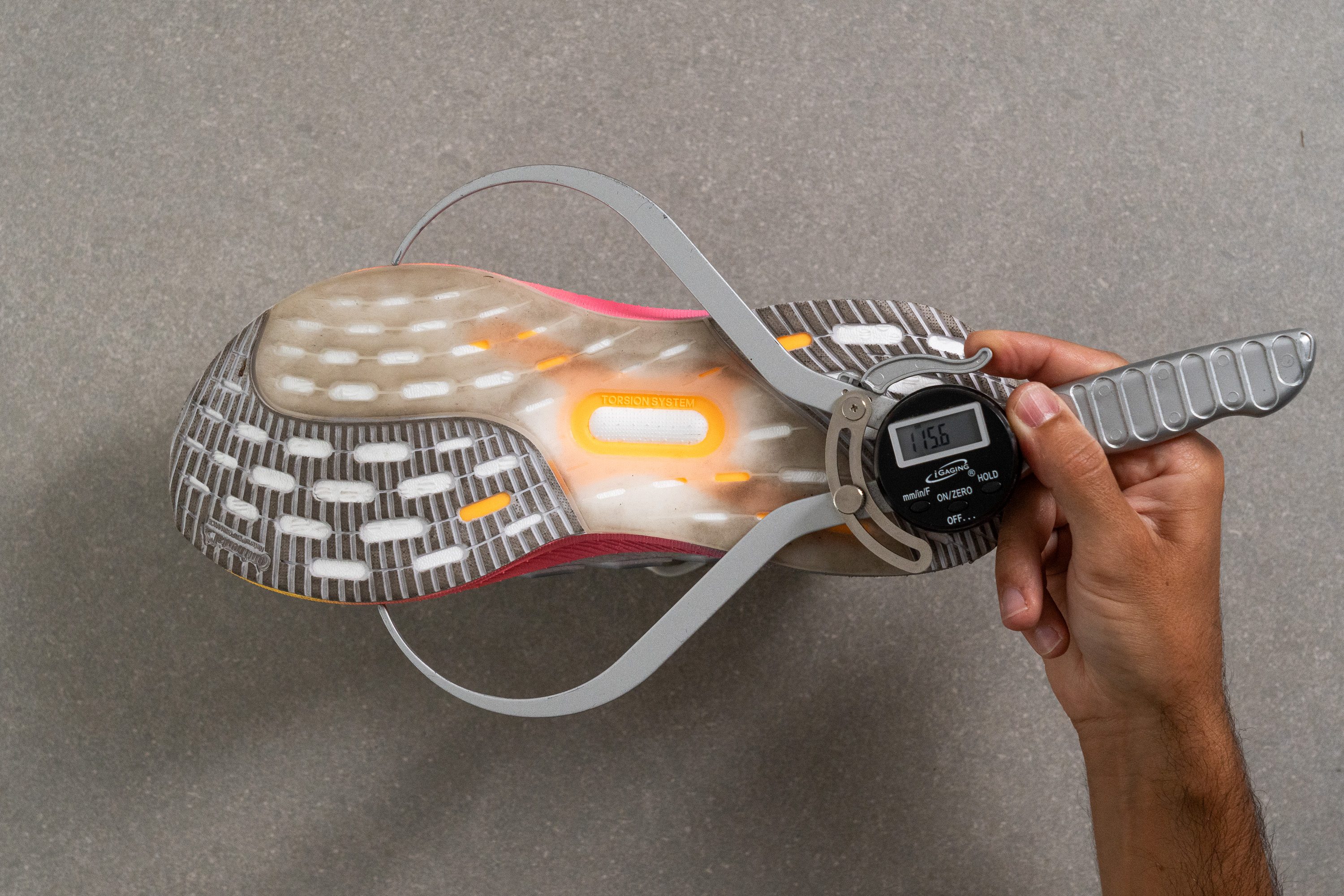
| Ultraboost 5 | 115.6 mm |
| Average | 114.4 mm |
Midsole width - heel
Similarly, we discovered that the Ultraboost 5 boasts the widest heel (94.3 mm) in its series to date.
We believe that this feature, combined with the Torsion System and large plastic clips on the sides of the heel, provides rearfoot strikers with a more centred and stable ride than before.
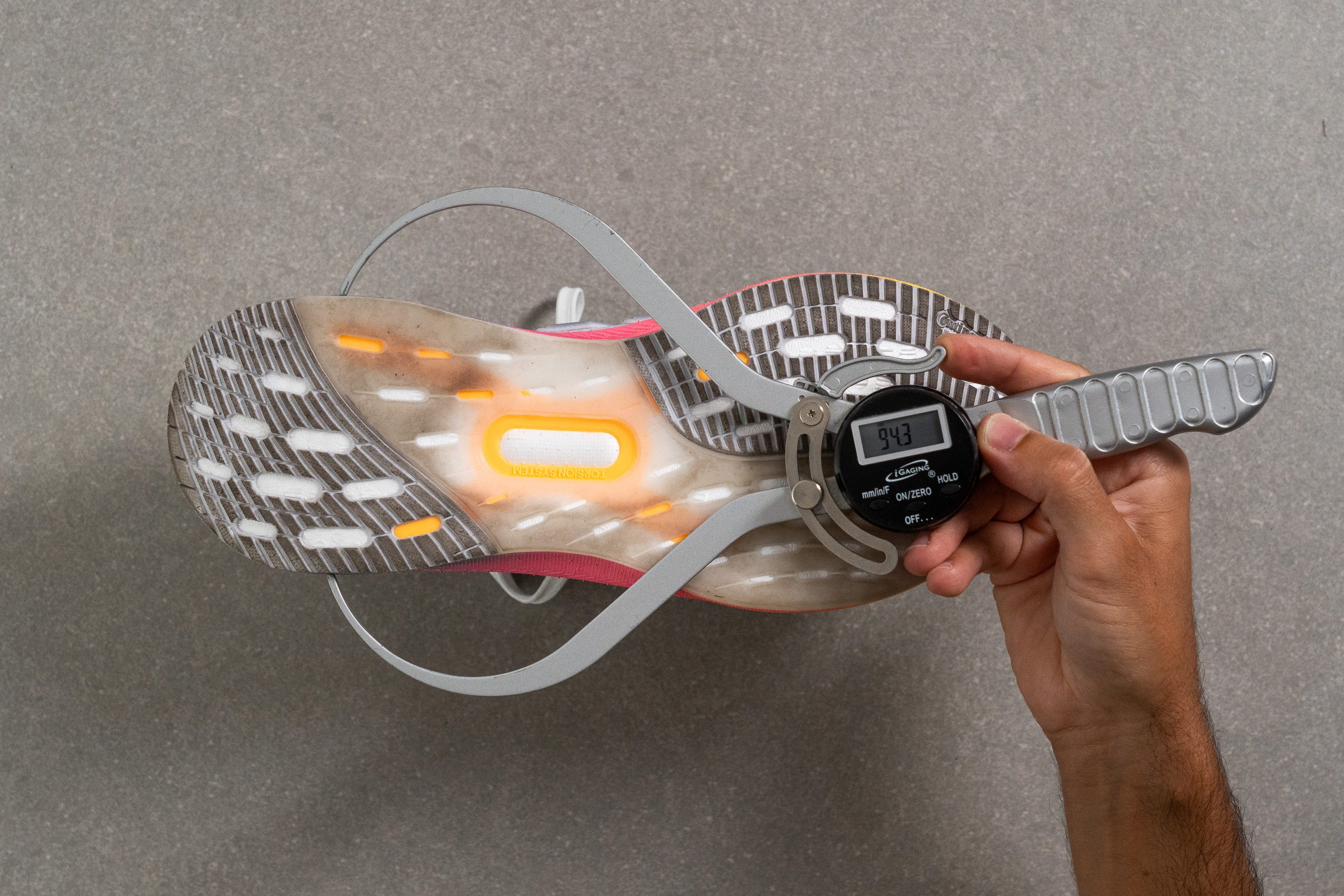
| Ultraboost 5 | 94.3 mm |
| Average | 90.7 mm |
Heel bevel
In line with recent Adidas models such as the Supernova Rise, the Ultraboost 5 incorporates an angled heel bevel that smooths transitions for heel strikers lacking a more centred footstrike.
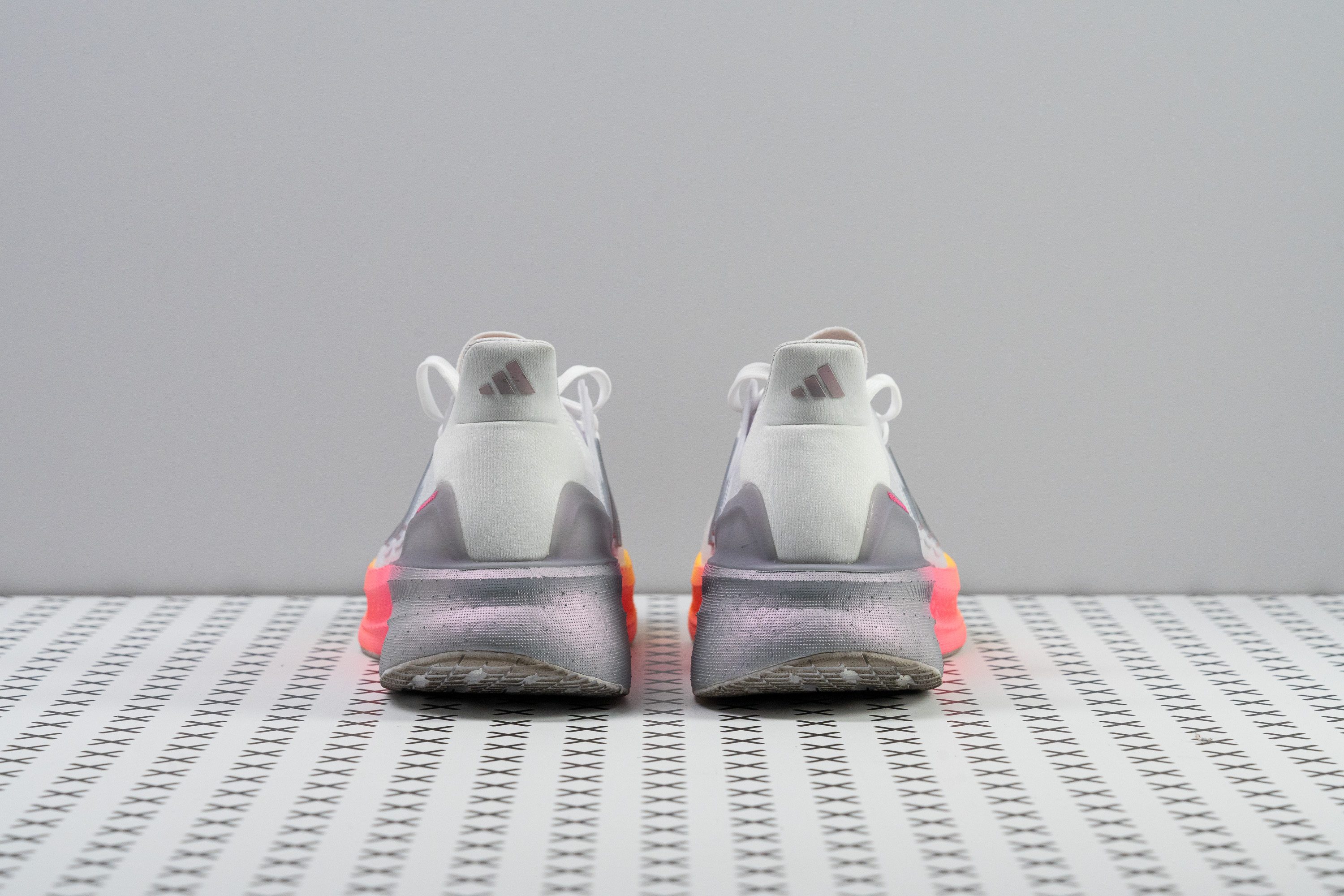
Durability
Toebox durability
Durability is always a concern in the lab when it comes to knit uppers, as the softer yarns tend to be more prone to wear and tear.
However, we were pleasantly surprised by the UB5’s performance, which proved to be more tough than we anticipated. Based on our analysis, this upper earned a decent 3/5 in durability. The Primeknit displayed great toughness despite being extremely breathable.

| Ultraboost 5 | 3 |
| Average | 2.6 |
Heel padding durability
After testing the toebox in the lab, we shifted our focus to the heel padding—an area of concern for many runners, especially those who experience wear in the heel.
In contrast to the toebox where we got a run-of-the-mill score, we found that Adidas truly excelled here. The heel padding ticks all the boxes for comfort and durability. Based on our evaluation, it earned a well-deserved 5 out of 5.

| Ultraboost 5 | 5 |
| Average | 3.4 |
Outsole hardness
One of the standout features that made the Ultraboost 1.0 incredibly popular was its excellent Continental outsole, which offered exceptional grip and impressive durability. We discovered that Adidas has continued its partnership with the German car tyre manufacturer in the Ultraboost 5, setting high expectations here in the lab.

Our initial evaluation focused on the hardness of the rubber, which was surprisingly lower than average at just 69.1 HC. This explains the excellent traction we experienced across various terrains, but it also raises concerns about the potential for durability issues.
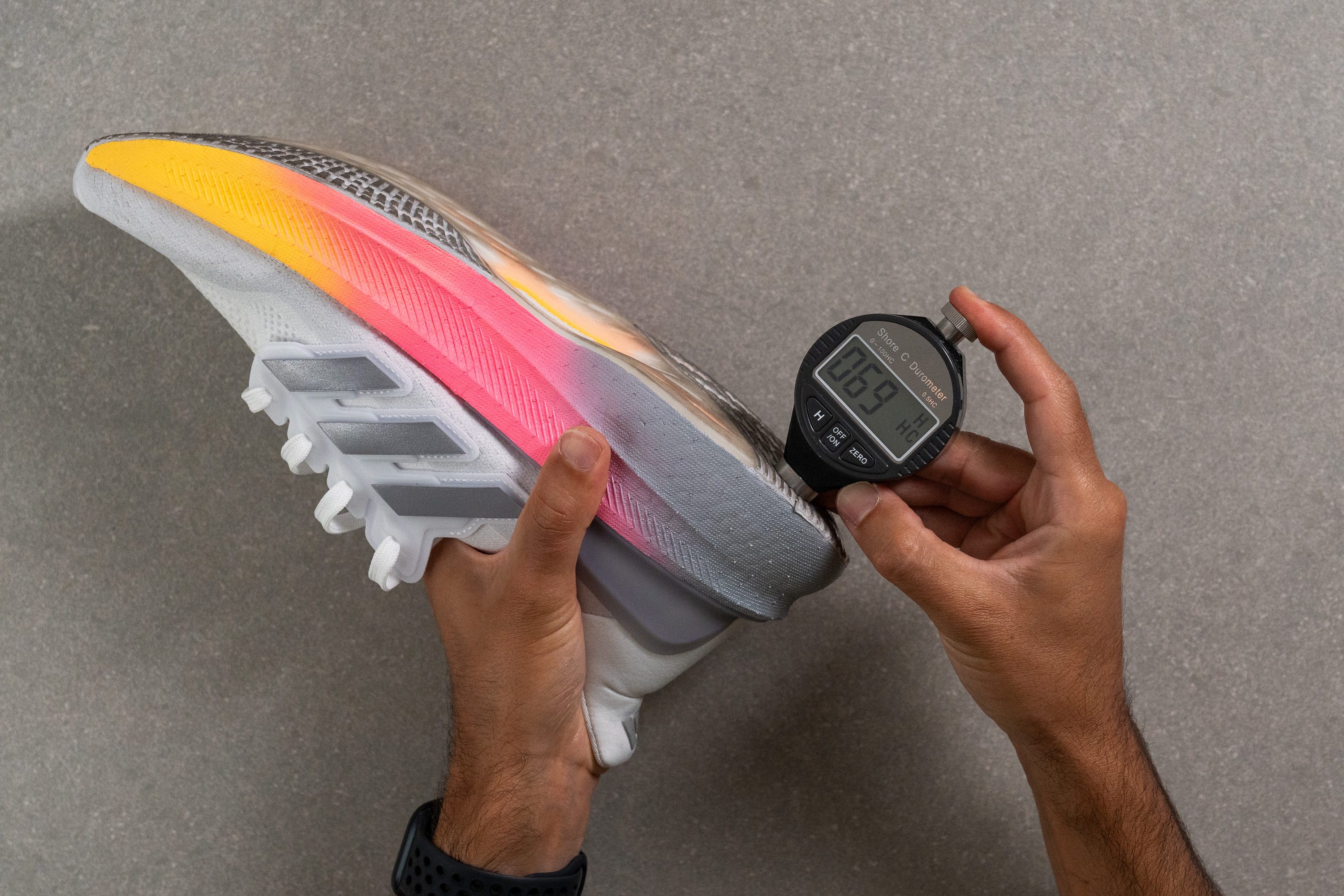
| Ultraboost 5 | 69.1 HC |
| Average | 79.2 HC |
Outsole durability
To determine if our concerns about durability were justified, we conducted a final test using our Dremel for the third and last time in this lab review.
What we discovered is striking—the toughness of the Continental compound is outstanding. We observed only a 0.8 mm dent. While this might seem just an average result, it's quite impressive for such a soft rubber!
| Ultraboost 5 | 0.8 mm |
| Average | 1.1 mm |
Outsole thickness
We were really confident about the outsole's durability when we measured its thickness at 2.8 mm, which, based on our previous tests, seems more than sufficient for this shoe.

From our evaluation, it appears that most runners will likely wear out other parts of the Ultraboost 5 before the outsole shows significant wear.
| Ultraboost 5 | 2.8 mm |
| Average | 3.2 mm |
Misc
Insole thickness
The insole is noticeably thinner than what’s typical in daily running shoes, measuring just 3.1 mm.
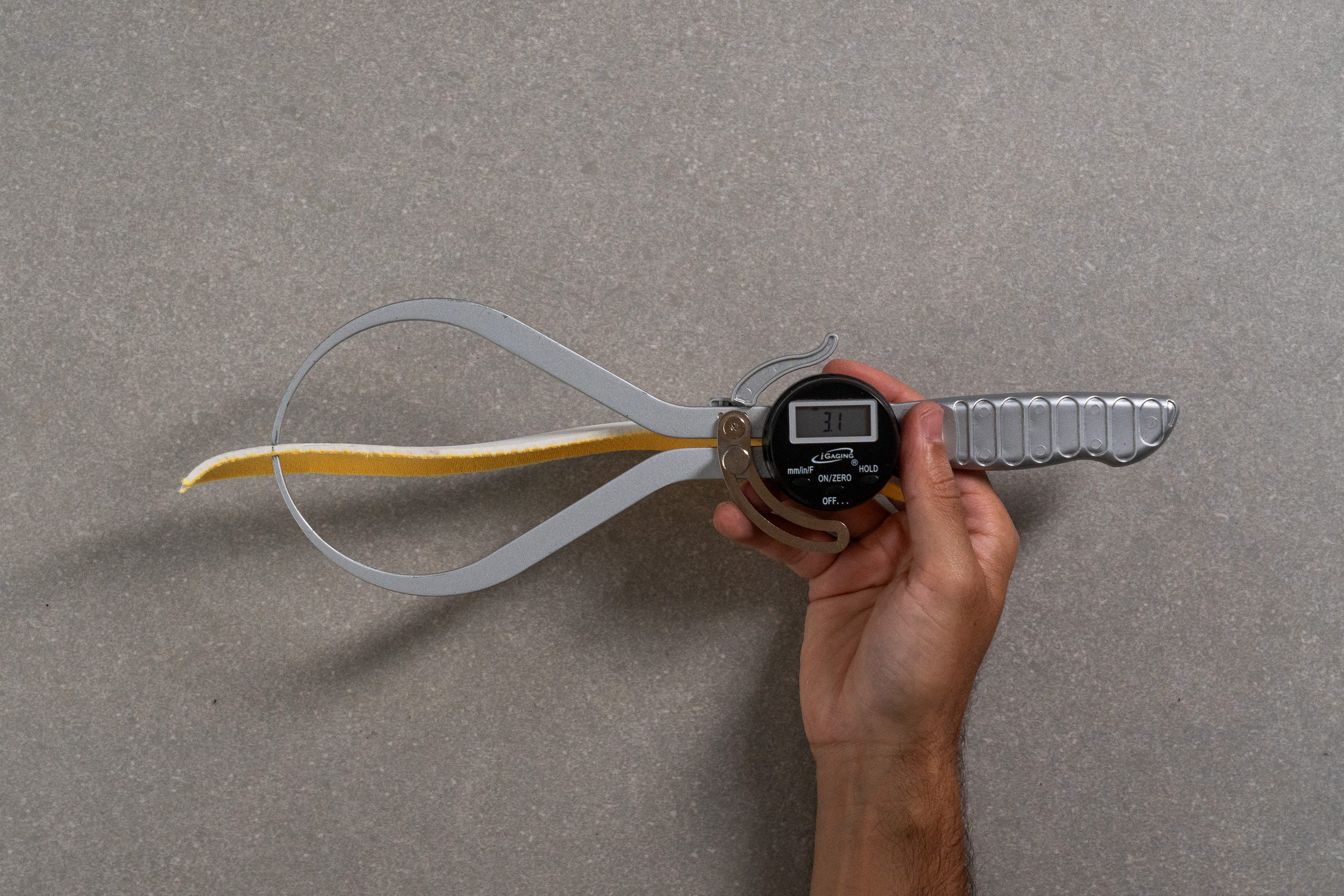
| Ultraboost 5 | 3.1 mm |
| Average | 4.5 mm |
Removable insole
You can easily replace the insole with an aftermarket footbed without any issues. We found that the toebox measurements indicate there’s sufficient space for those who prefer a third-party thicker footbed.
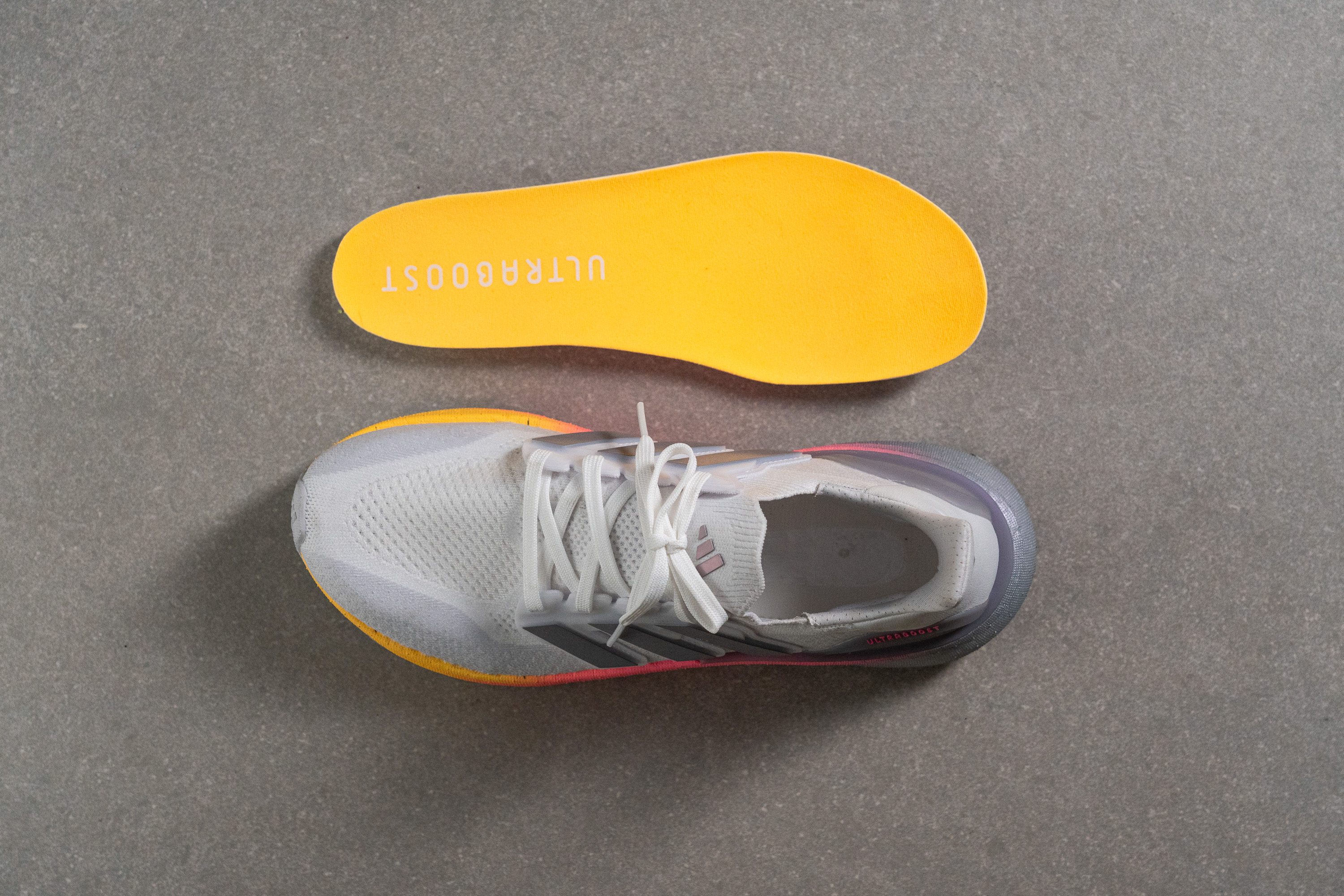
| Ultraboost 5 | Yes |
Midsole softness in cold (%)
Light Boost main component is not EVA, but TPU. As a result, it performs significantly better in cold temperatures compared to cheaper, entry-level foams. After 20 minutes in our freezer, it became only 16.9% firmer.

| Ultraboost 5 | 17% |
| Average | 24% |
Reflective elements
It's disappointing that Adidas chose not to include any reflective elements in their latest Ultraboost. In our view, at a £180 price point, the addition of a few reflective details would have been more than reasonable.
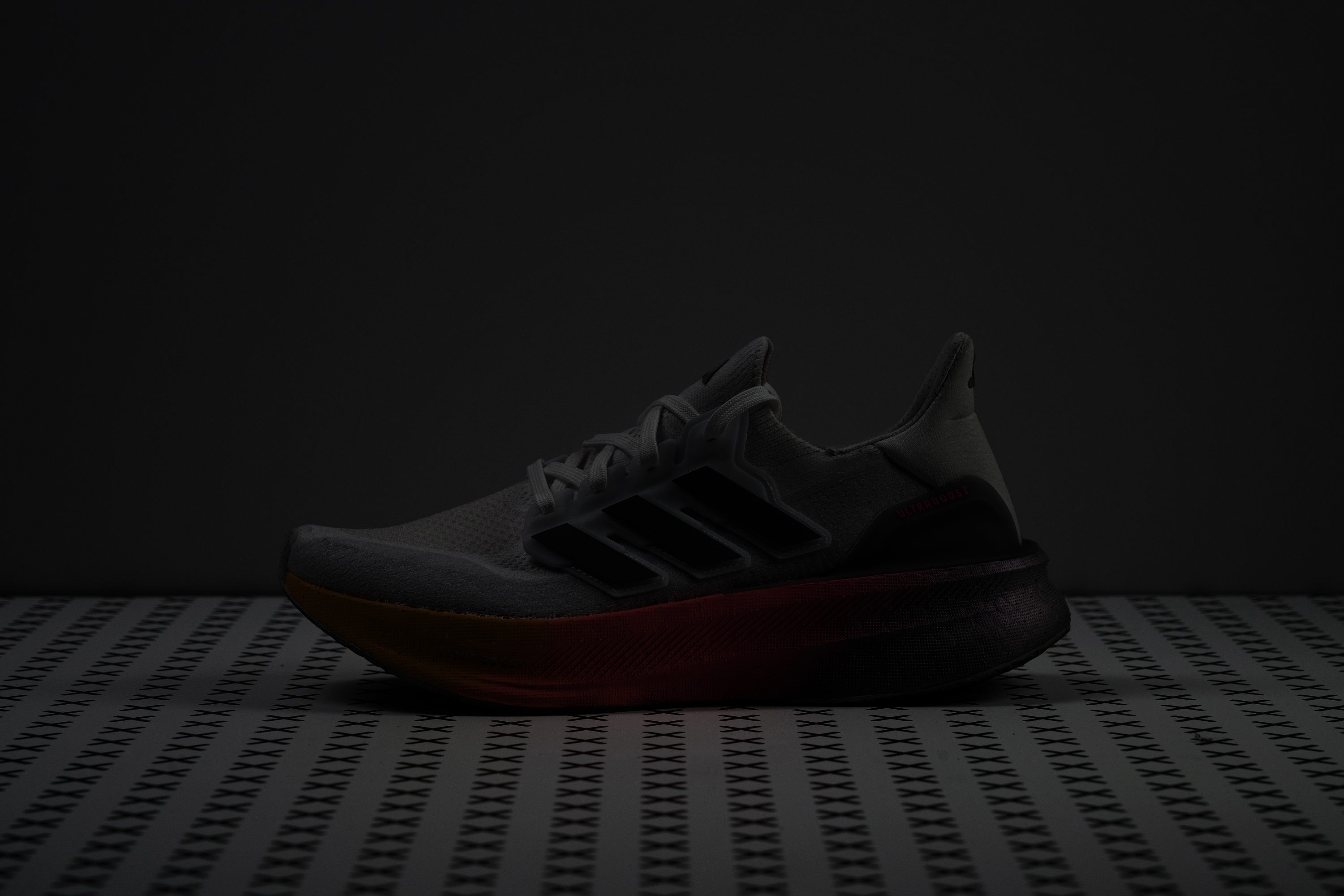
| Ultraboost 5 | No |
Tongue padding
As with most sock-like tongues, the padding on the Ultraboost 5 is minimal at just 1.2 mm, which might be an issue for those who experience discomfort or biting in the instep.
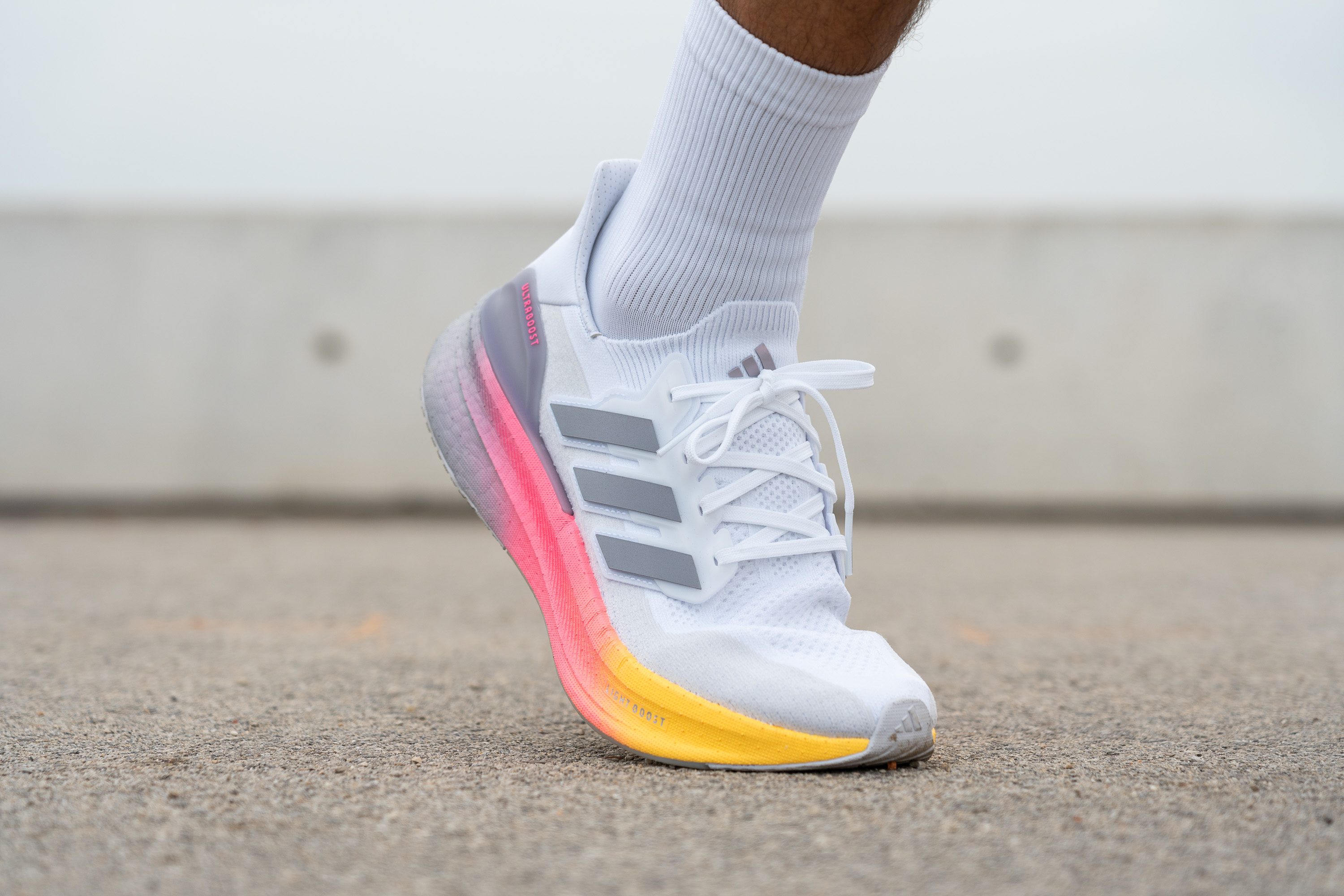
For those who prefer a more cushioned tongue, we recommend considering the ASICS Nimbus 26. It offers ample cushioning, a super-comfortable knit upper, and a more padded tongue for enhanced comfort.
| Ultraboost 5 | 1.2 mm |
| Average | 5.8 mm |
Tongue: gusset type
We can’t picture an Ultraboost without its signature sock-like tongue design—it’s a key feature that defines the comfort and fit of this shoe. And we're pleased to report that it's still here, delivering the same secure and cozy fit we've come to love since the first Ultraboost launched almost 10 years ago.
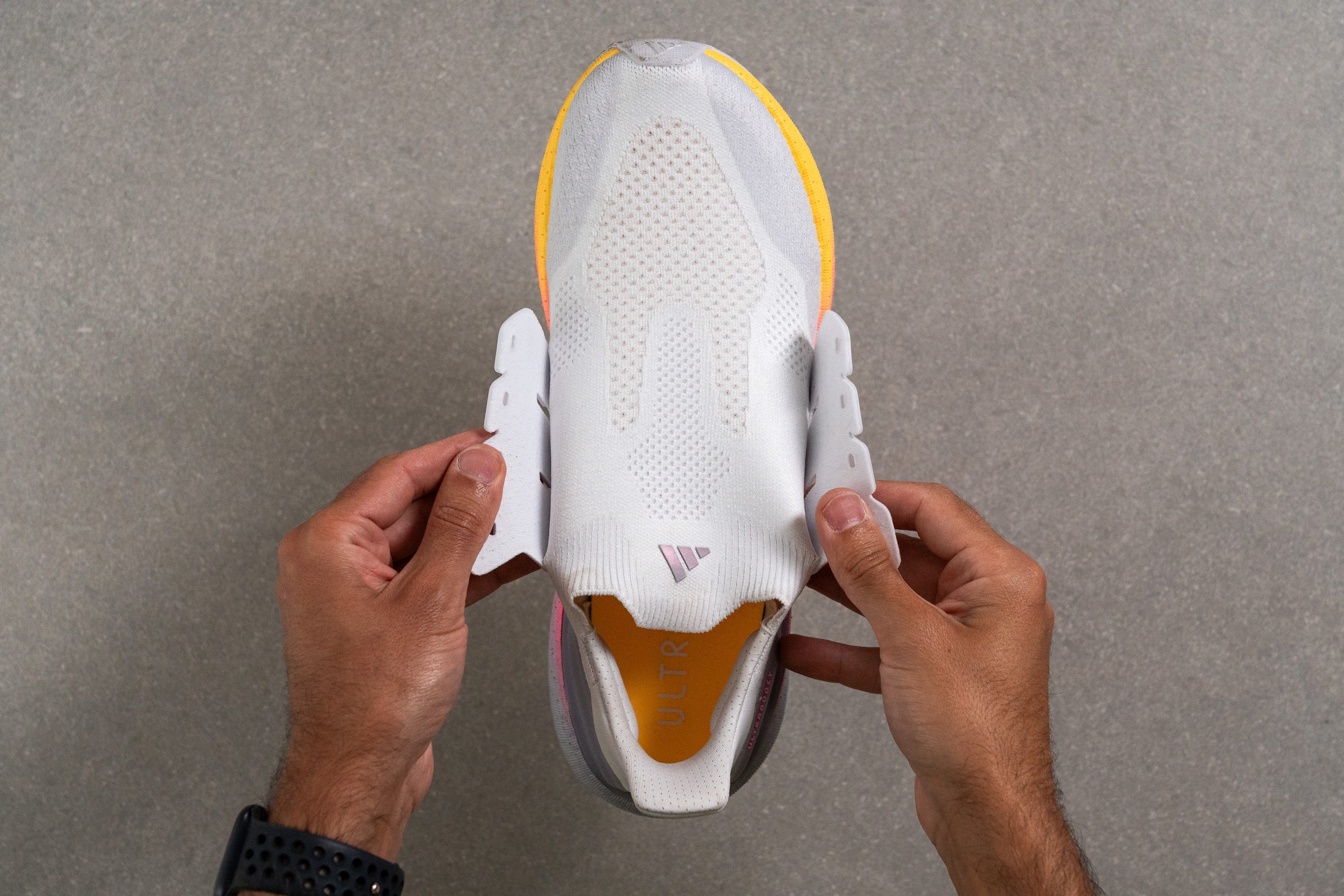
| Ultraboost 5 | Sock like |
Heel tab
One of the signature design elements of every Ultraboost has been its extended heel collar. We found that this feature not only protects the Achilles tendon but also makes it easier to slide your foot into the shoe by pulling on it. The Ultraboost 5 continues this tradition.
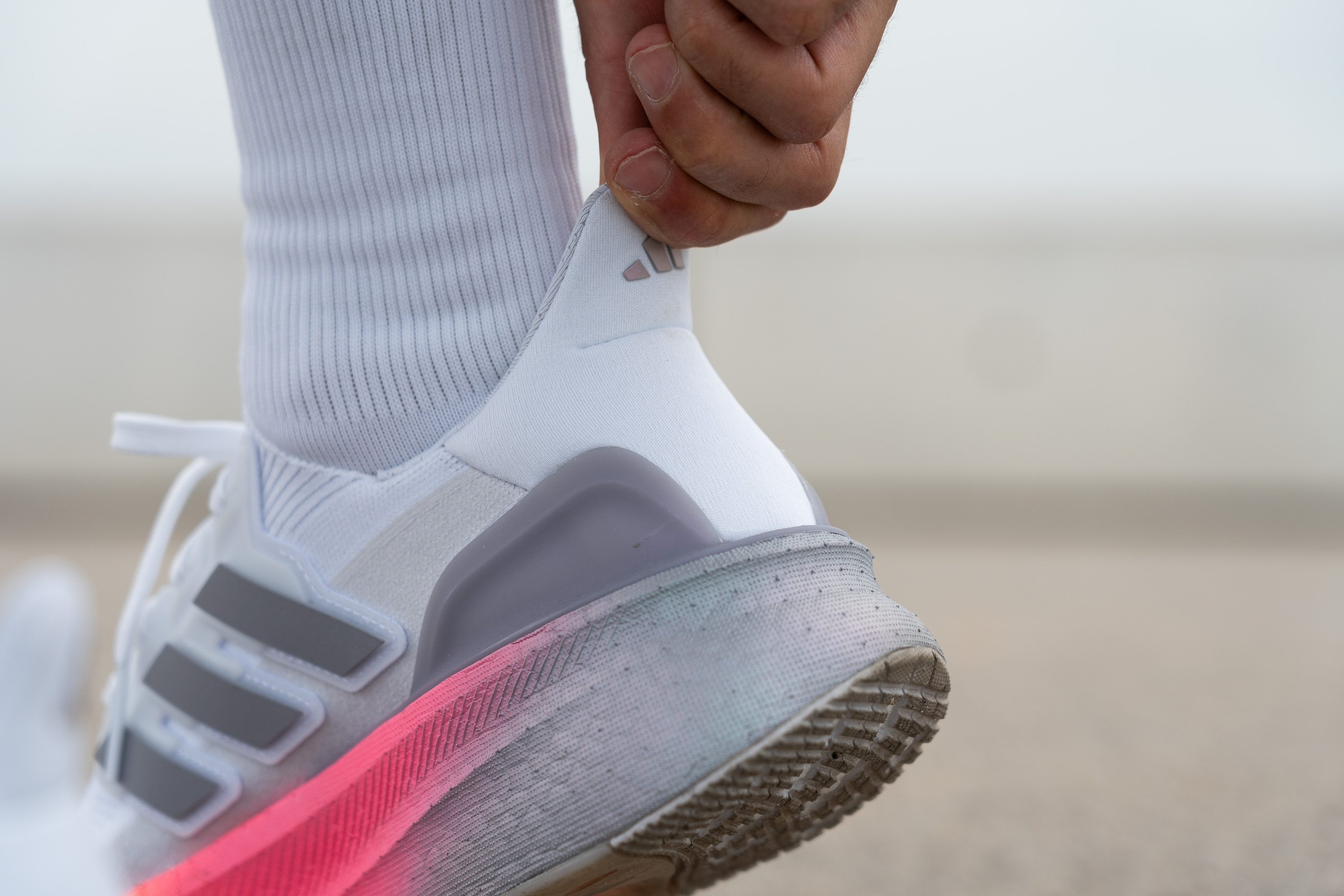
| Ultraboost 5 | Extended heel collar |

